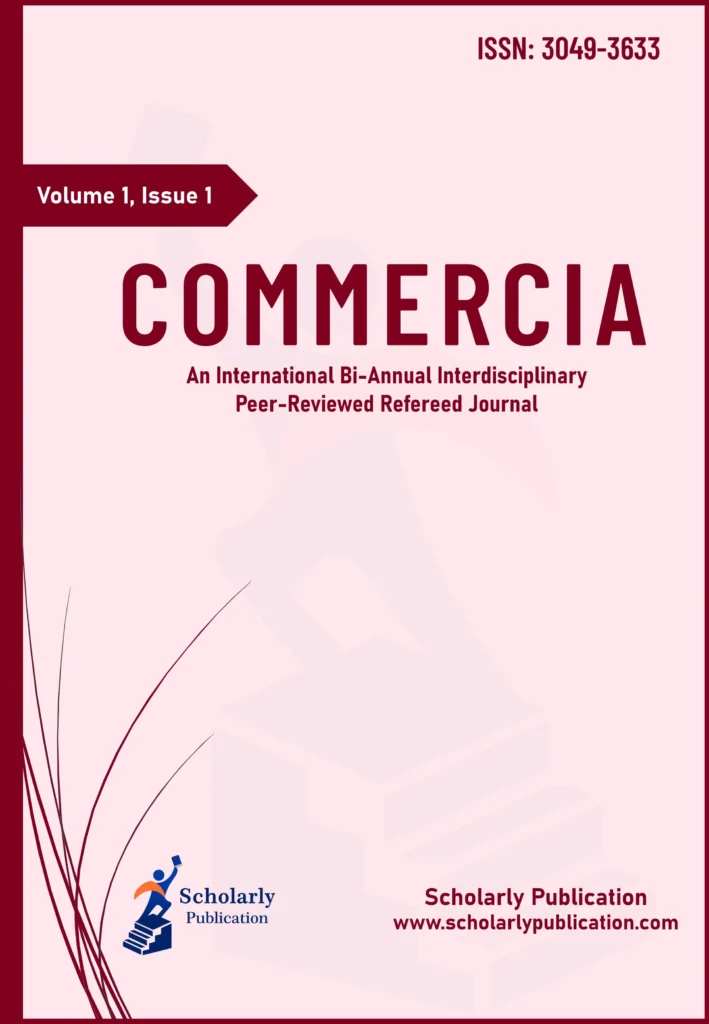India's Export Dynamics: A Comparative Analysis of the United States
Volume 1, Issue 1, Article Number: 251003 (2025)
Home >> Commercia >> Volume 1, Issue 1
1Associate Professor, Department of E.A.F.M., S.P.C. Government College, Ajmer (India)
2Assistant Professor, Department of E.A.F.M., S.P.C. Government College, Ajmer (India)
*Corresponding author: nvijaynarwal@gmail.com
Received: 01 January 2025 | Revised: 17 January 2025
Accepted: 18 January 2025 | Published Online: 18 January 2025
DOI: https://doi.org/10.5281/zenodo.15108423
© 2025 The Authors, under a Creative Commons license, Published by Scholarly Publication
Abstract
This study investigates India’s export dynamics, with a particular focus on its trade relationship with key global partners, especially the United States. Over the years, India’s exports have grown significantly. The export intensity index reveals that India’s trade with the United States is robust, accounting for 18% of India’s total exports in 2023, the concentration index indicates a moderate diversification in India’s export portfolio, although certain markets like the UAE and China exhibit higher concentration. For instance, the UAE’s export intensity index has increased from 11.4 in 1988 to 39.04 in 2022, showcasing its growing importance, while Japan’s index fell from 57.79 to 7.10 during the same period, reflecting diminishing trade ties. Despite a significant rise in overall exports, challenges persist, including a widening trade deficit, tariff barriers, and limited integration into global value chains.
Keywords
Export Intensity Index, Export Concentration Index, Global Value Chains (GVCs), Regional Comprehensive Economic Partnership (RCEP), Comprehensive Economic Partnership Agreement (CEPA)
References
- Balassa, B. (1965). Trade liberalisation and “revealed” comparative advantage1. The Manchester School, 33, 99-123.
[View Article] [Google Scholar]
- Dhiman, R. (2020). The textile industry and exports in post-liberalization India. Routledge India.
- DM, M., Gunadal, N. M., HC, H., Geetha, I., Sri, K. K., Haripriya, S., & Hanumanthappa, R. (2024). A Comprehensive Analysis of Export Performance and Trade Competitiveness of Millets from India. Journal of Scientific Research and Reports, 30, 43-55.
[View Article] [Google Scholar]
- Finger, J. M., & Kreinin, M. E. (1979). A measure ofexport similarity’and its possible uses. The Economic Journal, 89, 905-912.
[View Article] [Google Scholar]
- (2007). OECD Economic Surveys: Ukraine 2007, OECD Publishing, Paris, 117 p.
- Herfindahl, O. C. (1950). Concentration in the US steel industry. Unpublished PhD. Dissertation, Columbia University.
- Krugman, P. (1980). Scale economies, product differentiation, and the pattern of trade. American Economic Review, 70, 950-959.
- Kumar, N. (2002). Globalization and the Quality of Foreign Direct Investment. Oxford University Press.
- Li, M. (2024). A Study of the Prospects and Opportunities for India’s Development in a Competitive Environment between the US and China: Based on International Trade. International Journal of Global Economics and Management, 3, 364-370.
[View Article] [Google Scholar]
- Panagariya, A. (2010). India: The emerging giant. Oxford University Press.
Cite This Article
V. Kumar and S. Gosai, “India’s Export Dynamics: A Comparative Analysis of the United States,” Commercia 1(1) (2025) 251003. https://doi.org/10.5281/zenodo.15108423
Rights & Permission
This is an open access article published under the Creative Commons Attribution (CC BY) International License, which allows unrestricted use, distribution, and reproduction in any medium, provided the original work is properly cited. No permission is needed to reuse this content under the terms of the license.
For uses not covered above, please contact the Scholarly Publication Rights Department.

